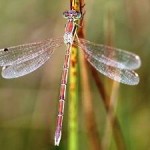The secret of a brilliant evolutionary development, spider web glue, has been discovered by University of Akron researchers. The finding by UA Ph.D. candidate Vasav Sahni and professors Ali Dhinojwala of the Department of Polymer Science and Todd Blackledge of the Department of Biology, was released by ‘Nature Communications’ (May 17, 2010) in the article, “Viscoelastic Solids Explain Spider Web Stickiness”.

The discovery, according to the scientists, has significant implications in mimicking bio-adhesives, a field in which the University is taking a leading role in collaboration with its regional research partners and the medical community.
Most of the research in this area of bio-adhesives focuses on discovering the molecule responsible for adhesion, explain Sahni and Dhinojwala.
“The success of an adhesive, however, depends on how efficiently the force is transmitted through the adhesive,” Sahni notes.
Dhinojwala adds that the micron-sized glue drops produced by spiders are composed of highly entangled polymers, which are physically or chemically cross-linked and transmit forces efficiently. Consequently, they are at least a 100 times superior to a viscous drop with the same adhesive molecule.
“Existence of similar adhesion strategies in distantly related species of animals suggests a common design principle in the evolution of natural adhesives,” Blackledge says.
“We were able to validate this finding through micro-mechanical stretching of single glue droplets. The elastic properties of the proteins found in the spider glue were crucial in increasing the adhesive forces,” Dhinojwala says.
Sahni notes that the stickiness of the glue droplets depends on the speed at which they are stretched. Subsequently, the glue droplets can hold on to fast-flying insects when they initially impact webs and retain trapped insects for a time period long enough for them to be subdued by the spider.
“This finding should significantly benefit the development of synthetic adhesives for biomedical, orthopedics and wound-healing applications. The understanding of how spiders use this unique glue will allow scientists to develop reversible adhesives that work in the presence of water,” says Dhinojwala.
Note: This story has been adapted from a news release issued by the University of Akron.
Related Features:














